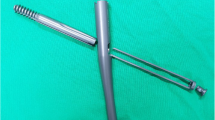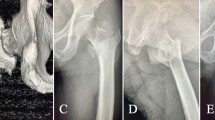Abstract
A tip-apex distance (TAD) of greater than 25 mm has been shown to be an accurate predictor of lag screw cut-out when sliding hip screws (SHS) are used to treat peritrochanteric (PT) hip fractures. The purpose of this study was to determine which factors, including TAD, correlated with successful clinical outcomes of PT hip fractures surgically treated with intramedullary (IM) devices. A total of 192 patients were included in this retrospective study. The TAD values of this cohort were radiographically analysed at a mean follow-up of 13 months. This was correlated with limited functional status and the rate of revision for implant failure or inability to achieve fracture union. Only 82 patients had adequate follow-up to fracture union or definitive failure. There were 46 intertrochanteric (IT) hip fractures and 36 subtrochanteric (ST) fractures. Overall, seven patients (8.5%) went on to experience lag screw cut-out. The average TAD of the patients who did not cut-out was 18 mm, compared to 38 mm for those who did (p = 0.012). All patients who cut-out had IT fractures (p = 0.017). The percentage of cut-outs correlated directly to both the severity of IT fractures and the TAD. Using a cutoff of 25 mm there was a statistically significant difference in the incidence of lag screw cut-out (p < 0.001). As in sliding hip screws, surgeons should strive for a TAD less than 25 mm when using IM devices in the treatment of PT hip fractures to help avoid lag screw cut-out.



Similar content being viewed by others
References
Johnell O, Kanis JA (2004) An estimate of the worldwide prevalence, mortality and disability associated with hip fracture. Osteoporos Int 15(11):897–902
Hannan EL, Magaziner J, Wang JJ, Eastwood EA, Silberzweig SB, Gillbert M, Morrison RS, McLaughlin MA, Orosz GM, Siu AL (2001) Mortality and locomotion 6 months after hospitalization for hip fracture: risk factors and risk-adjusted hospital outcomes. JAMA 285(21):2736–2742
van Balen, R, Steyerberg EW, Polder JJ, Ribbers TL, Habbema JD, Cools HG (2001) Hip fracture in elderly patients: outcomes for function, quality of life, and type of residence. Clin Orthop Relat Res (390):232–243
Braithwaite RS, Col NF, Wong JB (2003) Estimating hip fracture morbidity, mortality and costs. J Am Geriatr Soc 51(3):364–370
Burge R, Dawson-Hughes B, Solomon DH, Wong JB, King A, Tosteson A (2007) Incidence and economic burden of osteoporosis-related fractures in the United States, 2005–2025. J Bone Miner Res 22(3):465–475
Massoud EIE (2009) Fixation of basicervical and related fractures. Int Orthop. doi:10.1007/s00264-009-0814-1
Baumgaertner MR, Curtin SL, Lindskog DM (1998) Intramedullary versus extramedullary fixation for the treatment of intertrochanteric hip fractures. Clin Orthop Relat Res (348):87–94
Sadowski C, Lübbeke A, Saudan M, Riand N, Stern R, Hoffmeyer P (2002) Treatment of reverse oblique and transverse intertrochanteric fractures with use of an intramedullary nail or a 95 degrees screw-plate: a prospective, randomized study. J Bone Joint Surg Am 84-A(3):372–381
Park SR, Kang JS, Kim HS, Lee WH, Kim YH (1998) Treatment of intertrochanteric fracture with the gamma AP locking nail or by a compression hip screw-a randomised prospective trial. Int Orthop 22(3):157–160
Utrilla AL, Reig JS, Muñoz FM, Tufanisco CB (2005) Trochanteric gamma nail and compression hip screw for trochanteric fractures: a randomized, prospective, comparative study in 210 elderly patients with a new design of the gamma nail. J Orthop Trauma 19(4):229–233
Mahomed N, Harrington I, Kellam J, Maistrelli G, Hearn T, Vroemen J (1994) Biomechanical analysis of the gamma nail and sliding hip screw. Clin Orthop Relat Res (304):280–288
Liu M, Yang Z, Pei F, Huang F, Chen S, Xiang Z (2009) A meta-analysis of gamma nail and dynamic hip screw in treating peritrochanteric fractures. Int Orthop. doi:10.1007/s00264-009-0783-4
Baumgaertner MR, Curtin SL, Lindskog DM, Keggi JM (1995) The value of the tip-apex distance in predicting failure of fixation of peritrochanteric fractures of the hip. J Bone Joint Surg Am 77(7):1058–1064
Baumgaertner MR, Solberg BD (1997) Awareness of tip-apex distance reduces failure of fixation of trochanteric fractures of the hip. J Bone Joint Surg Br 79(6):969–971
Kyle RF, Gustilo RB, Premer RF (1979) Analysis of six hundred and twenty-two intertrochanteric hip fractures. J Bone Joint Surg Am 61(2):216–221
Seinsheimer F (1978) Subtrochanteric fractures of the femur. J Bone Joint Surg Am 60(3):300–306
Shyam Kumar AJ, Parmar V, Bankart J, William C, Harper WM (2006) Comparison of accuracy of lag screw placement in cephalocondylic nails and sliding hip screw plate fixation for extracapsular fractures of the neck of femur. Int Orthop 30(5):320–324
Cummings SR, Rubin SM, Black D (1990) The future of hip fractures in the United States. Numbers, costs, and potential effects of postmenopausal estrogen. Clin Orthop Relat Res (252):163–166
US Congress (1994) Hip fracture outcomes in people age 50 and over. Background paper. Government Printing Office, Washington, DC, USA
Author information
Authors and Affiliations
Corresponding author
Rights and permissions
About this article
Cite this article
Geller, J.A., Saifi, C., Morrison, T.A. et al. Tip-apex distance of intramedullary devices as a predictor of cut-out failure in the treatment of peritrochanteric elderly hip fractures. International Orthopaedics (SICOT) 34, 719–722 (2010). https://doi.org/10.1007/s00264-009-0837-7
Received:
Revised:
Accepted:
Published:
Issue Date:
DOI: https://doi.org/10.1007/s00264-009-0837-7




